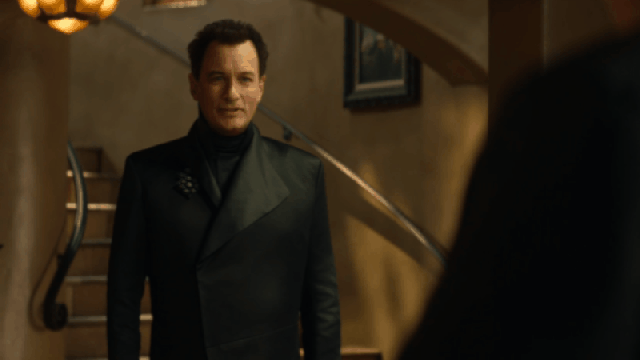There’s a moment in the climax of Star Trek: Picard’s season two premiere when Q, the omnipotent bane of Jean-Luc’s life, appears in the latter’s humble French estate. He has had, like so many returning figures of classic pop culture of late, the process of time smoothed out by CG, to give us a semblance of the Q we once knew all those years ago. But, he realises: Jean-Luc Picard has gotten old. So why shouldn’t he?
“Oh dear, you’re a bit older than I imagined,” Q jokes. “Let me catch up.” In a trademark click of his fingers, and a bright flash of light, the CG-enhanced Q becomes just regular old contemporary John de Lancie. It’s a perfect way to bring Q and Picard together again, decades after they last crossed paths in the finale of The Next Generation — but it’s also emblematic of an approach contemporary Star Trek is taking to its ageing heroes. Instead of being rooted in the moment we left these figures trapped in televisual amber generations ago, for the most part Star Trek has returned to them as they are in the here and now: actors and characters alike who have grown older and lived lives beyond the events we saw played out on screen.
Q’s brief de-ageing isn’t the first time Trek has leveraged the technology — in Picard’s first season, Brent Spiner appeared multiple times in a mix of makeup and CG touch ups to portray the “ageless” Commander Data, while appearing as his normal self as Dr. Altan Soong. But it’s been rare for the series as its renaissance in the streaming age has plunged into the depths of Star Trek’s past and its future. The franchise has worked inversely too — in shows like Discovery and the upcoming Strange New Worlds, set in Trek’s 23rd century “past,” revisiting younger versions of famous figures like Spock, Sarek, Uhura or Captain Pike has been managed by recasting new faces, giving the chance in turn for those actors to put their own interpretive mark on Star Trek legends. And where neither approach necessarily works, there’s always animation: Lower Decks provided ways for us to revisit characters in their Starfleet heydays like Tom Paris, or Commander Riker and Deanna Troi. Prodigy even had it both ways, with Kate Mulgrew reprising her role as both a Voyager-era Captain Janeway (in holographic form) and what would be the contemporary Admiral Janeway.

It’s made all the more fascinating to see this multi-pronged approach in contrast to Trek’s long-time sci-fi “rival,” Star Wars. In some ways there are parallels — new faces stepping in to portray new chapters of classic figure’s lives, like Alden Ehrenreich as the young Han Solo, or Rosario Dawson as a post-Return of the Jedi Ahsoka Tano. In series like The Bad Batch, Rebels, and Clone Wars, we’ve seen familiar faces return, whether played by their cinematic counterparts or by soundalikes, allowing them to exist and live stories across multiple eras of the Star Wars timeline. But in stark contrast to Trek, Star Wars has leaned the most on using technology to recapture the youth of its legacy figures, to mixed degrees of success. From Rogue One’s digital replicas of Princess Leia and Grand Moff Tarkin, to the now-seemingly-ongoing deployment of a CG likeness of Mark Hamill to bring a Return of the Jedi era Luke Skywalker back to life in The Mandalorian and The Book of Boba Fett, Star Wars’ fascination with its past has seen it draw upon the technological influences that made the franchise a pioneer in the first place, attempting to use VFX to lock its heroes in that aforementioned amber. Who needs to tell stories about a Luke Skywalker that has grown old, when you can just place a young Mark Hamill’s digital face over a stunt actor, and relive an idealised past?
Of course, that’s not to say Star Wars didn’t try that: the old Luke we met in The Last Jedi, embittered by disillusion and years of self-imposed exile, offered a bold look at a hero who has grown from the glory days we last encountered him in, traumatized by the destiny placed upon his shoulders. The fact that the reaction to such an idea was rendered so controversial, however, that Star Wars has seemingly raced back to this CG-enhanced version of Luke’s past self in its wake is perhaps made more damning, then. What Star Trek has done with figures like Q and Picard, Star Wars has become too reluctant to try. But whatever the approach, in this age of revitalized franchises attempting to move and grow beyond their predecessors, how two of the biggest sci-fi hits have taken opposite stances on just how to best revisit their most iconic figures has become fascinating to watch unfold — whether through layers of digital trickery or otherwise.
